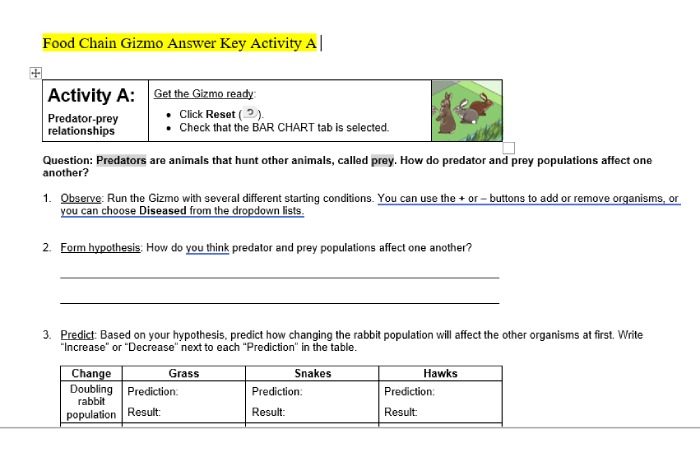The student exploration food chain answer key PDF, a valuable resource for educators and students alike, unveils the intricate workings of food chains within ecosystems. This comprehensive guide delves into the fundamental concepts of food chains, their components, and their significance in maintaining ecological balance.
Food chains, as defined in the answer key, represent the interconnected feeding relationships among organisms within an ecosystem. These chains illustrate how energy and nutrients flow from producers, such as plants, through various levels of consumers, including herbivores, carnivores, and decomposers.
Definition of Food Chain

A food chain is a linear sequence of organisms through which nutrients and energy pass, starting with a producer organism and ending with a top predator.
Food chains are essential for the functioning of ecosystems, as they ensure the transfer of energy and nutrients from one organism to another.
Components of a Food Chain
- Producers:Organisms that can produce their own food through photosynthesis or chemosynthesis.
- Consumers:Organisms that cannot produce their own food and must consume other organisms to obtain energy and nutrients.
- Decomposers:Organisms that break down dead organisms and recycle nutrients back into the ecosystem.
Types of Food Chains
- Terrestrial food chains:Occur on land, with producers such as plants and consumers such as animals.
- Aquatic food chains:Occur in water bodies, with producers such as algae and consumers such as fish and zooplankton.
- Marine food chains:Occur in oceans, with producers such as phytoplankton and consumers such as whales and sharks.
Energy Flow in Food Chains
Energy flows through a food chain in a unidirectional manner, from producers to consumers to decomposers.
At each trophic level, approximately 10% of the energy is transferred to the next level, with the remaining energy lost as heat.
Trophic Levels, Student exploration food chain answer key pdf
Trophic levels represent the position of an organism within a food chain based on its feeding habits.
- Producers:First trophic level (autotrophs)
- Primary consumers (herbivores):Second trophic level (eat producers)
- Secondary consumers (carnivores):Third trophic level (eat primary consumers)
- Tertiary consumers (top predators):Fourth trophic level (eat secondary consumers)
Food Webs
Food webs are more complex representations of feeding relationships in an ecosystem, as they include multiple interconnected food chains.
Food webs provide a more comprehensive understanding of the flow of energy and nutrients within an ecosystem.
Importance of Student Exploration
Student exploration is crucial for understanding food chains because it allows students to:
- Observe the interactions between organisms in different trophic levels.
- Investigate the flow of energy and nutrients through food chains.
- Develop an understanding of the importance of food chains for ecosystem stability.
FAQs: Student Exploration Food Chain Answer Key Pdf
What is the significance of food chains in ecosystems?
Food chains play a crucial role in maintaining ecological balance by ensuring the flow of energy and nutrients through different trophic levels. They regulate population dynamics, support biodiversity, and contribute to the overall stability of ecosystems.
How do decomposers contribute to food chains?
Decomposers, such as bacteria and fungi, play a vital role in food chains by breaking down dead organisms and organic matter. This process releases nutrients back into the ecosystem, making them available for producers to use in photosynthesis.
What are the different types of food chains?
There are various types of food chains, including terrestrial food chains, aquatic food chains, and marine food chains. Each type represents the feeding relationships among organisms in specific ecosystems, such as forests, lakes, or oceans.
